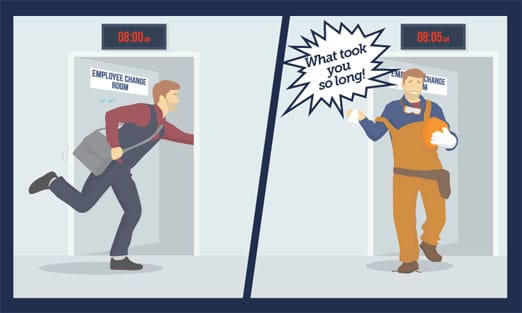SCOTUS to clarify “clothes” vs “work gear” for purposes of employee pay
U.S. labor laws stipulate that non-exempt, or hourly workers, must be paid for any and all time they are working. Essentially, working is defined as work done for the benefit of the employer.
However, defining work isn’t as black and white as one might assume. One such case, recently decided by the U.S. Supreme Court is a prime example.
The specifics of the case
The case involves roughly 800 unionized steel workers from a plant in Indiana. As part of their job, workers are required to wear flame-retarded type gear. However, each day workers need to devote time to put on and take off these items pre and post shift. They have argued that they should be paid for “donning and doffing” these items. Under the law, they argue, this is not unpaid work time.
Labor laws stipulate that employers are mandated to pay employees for the time it takes to put on and take off gear needed for a job. However, employers do not have to pay employees time to change regular “clothing.” This is even stipulated in the steel workers’ union contract.

The Court of Appeals for the 7th Circuit ruled in favor of the workers and stated that the items worn by the steel workers could not be classified as regular clothing and thus they should’ve been paid for the time to do such tasks.
The case is now in front of the U.S. Supreme Court.
The arguments
The workers have argued that the gear needed to perform their jobs is not clothing but “essential protective workplace” attire.
The company disagrees and argues that “donning and doffing” the items are simply wearable clothes and therefore, under the law, does not entitle them to be paid for the time to take the items on and off.
Statutory interpretation is now the issue before the U.S. Supreme Court. Will the attire be classified as clothing or work gear?
Predictions
The court has yet to make any ruling on the matter, but two Justices have already alluded to their opinions.
Justice Scalia indicated that since the statute specifically indicates “clothes” it should be read and interpreted literally. “Nobody would consider eyeglasses or a wristwatch or some of this other specialized equipment to be clothes. I mean, the word is what it is,” he stated.
Alternately, Justice Sotomayor indicated that the company’s definition of “clothing” for purposes of the law “might go too far.”
Past interpretations
It remains to be seen what the court’s final interpretation will be. The Labor department’s interpretation has fluctuated throughout the years.
During the Clinton administration, hats, boots and gloves weren’t classified as clothing but protective gear. This same gear was changed and classified as clothing in 2002 under Bush. Later, these same items were classified as clothing in 2010 under the Obama administration.
The U.S. Supreme Court is expected to issue a decision in June 2014. Along with the steel workers, the decision will also affect those in other sectors including workers in the poultry processing and meat packing fields.


